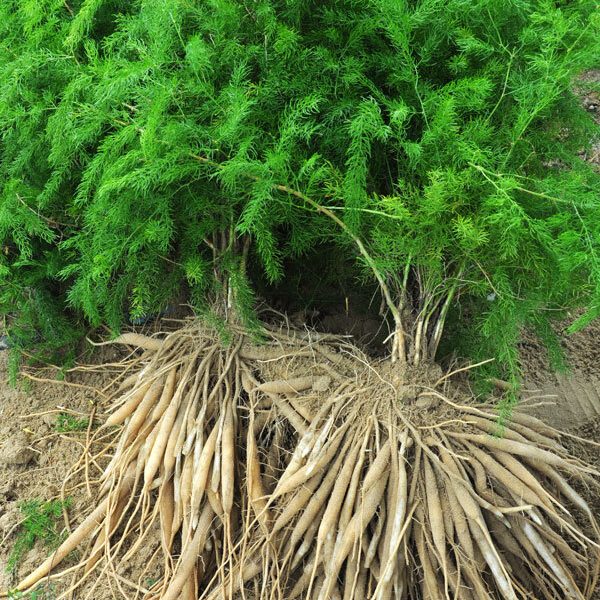Many herbs nourish body systems just like foods do. In fact, many herbs are related to foods we eat, Shatavari (Asparagus racemosus or A. racemosus) root is one of them. It is related to the food asparagus that many of us enjoy each spring. Shatavari is an Ayurvedic, adaptogen herb most-well known and used as an aphrodisiac and to enhance female fertility (although it enhances male fertility too).

Shatavari has many loose translations, each indirectly expressing its ability to rejuvenate reproductive organs, support sexual arousal and ability, increase fertility, and promote overall female vitality:
- “curer of a hundred diseases”
- “100 spouses”
- “who possesses a hundred husbands”
- “Queen of herbs”
Shatavari’s Top 5 Uses
1. Hormonal balance: Shatavari is known as an estrogen-regulating herb (and is one of the top phytoestrogens) which may be useful in regulating the menstrual cycle. It is also known to support the anterior pituitary gland, supporting the production of luteinizing hormone (LH).
In women, LH is responsible for triggering ovulation and development of the corpus luteum after ovulation. In men, LH stimulates specific cells to produce testosterone.
2. Healthy liver and kidney activity: Shatavari is a diuretic, helping the body to eliminate excess fluid build-up. This action may greatly help with fluid retention, specifically fluid retention prior to menstruation (PMS-related).
3. Counteracts stress: By nature of being an adaptogen, Shatavari encourages a healthy stress response. This makes Shatavari worth considering for those with stress-induced fertility health issues.
“In Ayurveda, Asparagus racemosus has been described as a rasayana herb and has been used extensively as an adaptogen to increase the non-specific resistance of organisms against a variety of stresses.” N. Bopana, S. Saxena in the Journal of Ethnopharmacology
4. Stimulates mucous membranes: Shatavari is mucilaginous making it useful for supporting the health of mucous membranes, including the mucous membranes of the cervix and seminal vesicles.
Shatavari can be useful for women needing to boost healthy cervical mucus production, or who experience vaginal dryness.
In men, mucous membranes in the seminal vesicles make nearly 60% of the semen ejaculated during intercourse. Shatavari may be one useful tool for men with low seminal volume while improving semen quality. Healthier semen indicates higher levels of nutrients in the semen. Two such nutrients are:
- fructose which gives sperm energy to move outside the male body
- prostaglandins which “are believed to aid fertilization by causing the mucous lining of the cervix to be more receptive to sperm as well as by aiding the movement of the sperm toward the ovum with peristaltic contractions of the uterus and fallopian tubes.”
5. Boosts immune system function: Shatavari is an immunomodulator, meaning it has the ability to stimulate the body to have a proper immune response. Couples with autoimmune fertility issues may be helped by boosting proper immunological function and should take time to learn more about Shatavari.
Shatavari may also be a useful galactagogue for women who need to encourage breast-milk production. It has also been useful for some women experiencing threatened miscarriage, with the support of a skilled Ayurvedic practitioner or Naturopathic Doctor.
Closing Thoughts
Adaptogen herbs offer us a gift. They meet each body where it’s at, sharing their medicine in way(s) each individual needs; be it to help withstand or provide stress relief, boost the immune system, or increase stamina including physical, mental and emotional strength. Shatavari is a Safety Class 1:A herb with no known contraindications or drug/supplement interactions according to the Botanical Safety Handbook.
- Alok, S., Jain, S. K., Verma, A., Kumar, M., Mahor, A., & Sabharwal, M. (2013). Plant profile, phytochemistry and pharmacology of Asparagus racemosus (Shatavari): A review. Asian Pacific Journal of Tropical Disease, 3(3), 242-251. doi:10.1016/s2222-1808(13)60049-3 Retrieved from: https://www.ncbi.nlm.nih.gov/pmc/articles/PMC4027291/
- Barton-Schuster, D. (n.d.). Shatavari: Fertility Herb from India. Retrieved from: http://natural-fertility-info.com/shatavari-fertility.html
- Bopana, N., & Saxena, S. (2007). Asparagus racemosus—Ethnopharmacological evaluation and conservation needs. Journal of Ethnopharmacology, 110(1), 1-15. doi:10.1016/j.jep.2007.01.001 Retrieved from: https://www.sciencedirect.com/science/article/pii/S0378874107000025?via%3Dihub
- Women’s Health: Unfolding Ancient Secrets. (n.d.). Retrieved from: https://organicindiausa.com/organic-india-blog/shatavari-cheat-sheet
- Gardner, Z. E., & McGuffin, M. (2013). American Herbal Products Association’s botanical safety handbook. Boca Raton: American Herbal Products Association, CRC Press.
- Lad, V., & Frawley, D. (1986). The yoga of herbs: An Ayurvedic guide to herbal medicine. Santa Fe, NM: Lotus Press.
- Seminal vesicle. (n.d.). Retrieved from: https://www.britannica.com/science/seminal-vesicle
- Winston, D., & Maimes, S. (2007). Adaptogens: Herbs for strength, stamina, and stress relief. Rochester, VT: Healing Arts Press.





